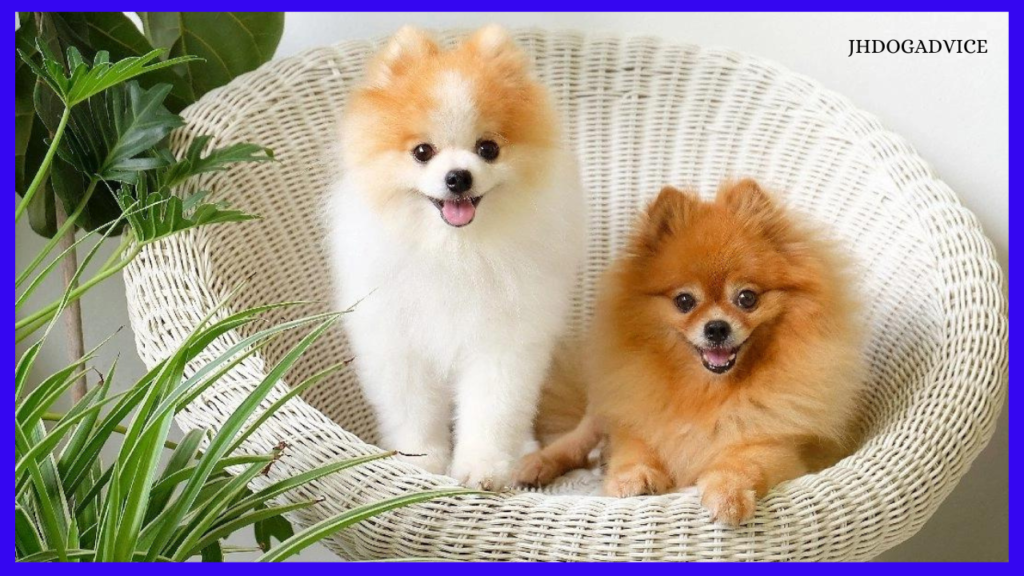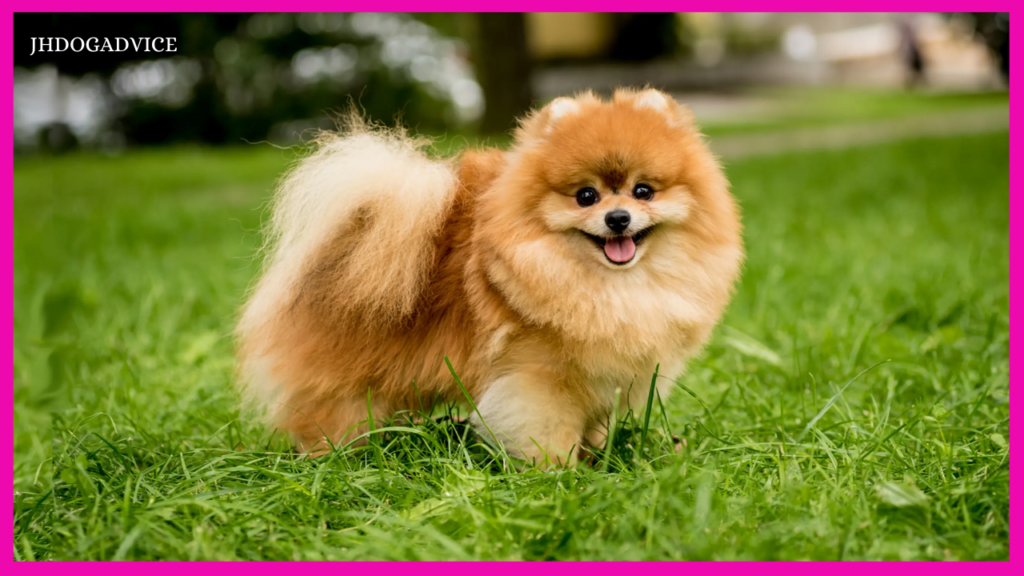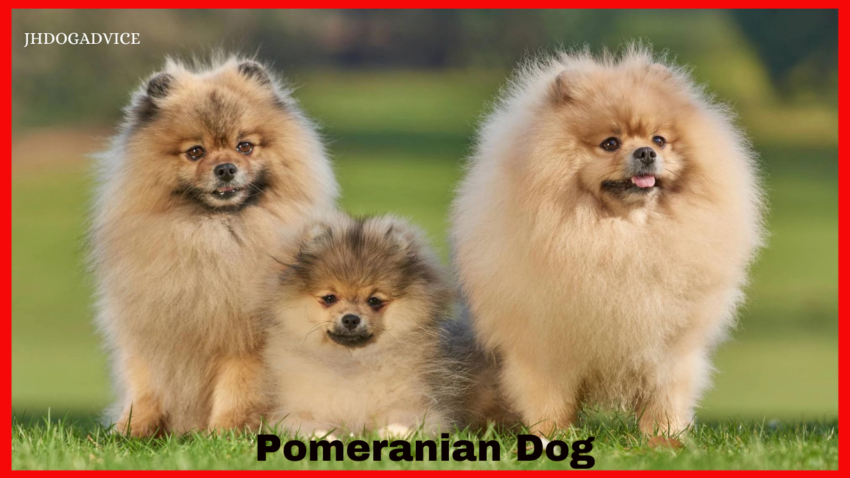Pomeranian Dog

The Pomeranian (often known as the Pom) is a spitz dog breed. It is named after the Pomerania region in north-west Poland and north-east Germany in Central Europe. Pomeranian, a breed of toy dog that can be traced – like the related Keeshond, Samoyed, and Norwegian Elkhound – to early sled-dog ancestors.
Pomeranians are intelligent, respond well to training, and can be very successful in getting what they want from their owners. They are extroverted and enjoy being the center of attention, but if not well-trained and socialized they can become dominant, willful, and stubborn. The toys can be used as an effective tool in training Pomeranians to spend time alone.
About the Breed
The Pomeranian is a small dog – a toy breed that weighs just several pounds – with a long coat and distinctive neck ruff reminiscent of their Spitz heritage. They have small upright ears, short legs and paws, and a curled tail. Their faces often draw people in – with bright eyes, a big smile, and alert expressions, these funny little balls of fluff are next-level cute and have become increasingly popular. Although they make loving and loyal pets, their small size and delicate build require careful care and supervision, especially around children and larger animals.
The Pomeranian is an adorable little dog with a generally friendly—though sometimes bossy—personality. Also called a “Pom,” this breed is extremely loyal to its loved ones and can be an effective guard dog despite its diminutive appearance.
- Origin: Pomerania Region (Poland and Germany)
- Other Name: Pom, Zwergspitz
- Size: Small, 6-7 inches tall, weighing 3-7 pounds
- Breed Group: Toy
- Lifespan: 12-16 years
- Coat: Thick double coat that varies in color, but is usually mostly orange, with black or brown markings, or solid white, or black and tan. While the White Pomeranian dog is most commonly recognized, the Black Pomeranian is considered rare. Other rare color color types include Lilac, Blue, and Wolf Sable.
- Temperament: Intelligent, loyal, affectionate, and playful
- Exercise needs: Low to moderate
- Training: Easy to train with positive reinforcement methods
- Popularity:
- The American Kennel Club ranked them as the 24th-most popular dog breed in the US in 2021 and the fourth-most popular breed in the toy group.
- In 2014, Paris Hilton spent $13,000 on the “world’s smallest Pomeranian,” an 11.6-ounce Teacup Pomeranian named Mr. Amazing.
- Queen Victoria was a fan of Pomeranians and helped to popularize the breed in the 19th century.
- Two Pomeranians survived the sinking of the Titanic.
- A Pomeranian named Jiff holds two Guinness World Records for the fastest 10-meter run on hind legs and the fastest 5-meter run on front legs.
History of the Pomeranian Dog

The history of the Pomeranian breed is particularly fascinating. Considered a mini-me version of the German Spitz dog, the Pomeranian was gradually selectively bred to be smaller and more diverse in color – they were even a favorite of Queen Victoria at the time!
The Pomeranian is considered a descendant of the German Spitz. The breed’s name is believed to come from a region called Pomerania, located along the Baltic Sea in northern Poland and Germany.
Many royal owners have popularized this breed since the 18th century. Queen Victoria specifically had a small Pomeranian and as a result, the small variety became universally popular. During Queen Victoria’s lifetime alone, the breed halved in size.
Pomeranian Size
The members of this breed don’t seem to realize how small they are, so it’s not uncommon to see them bark at or even tackle larger dogs. With their alert attitude and tendency to bark, Pomeranians make great watchdogs. They usually stand around 6 to 7 inches tall and can weigh between 3 to 7 pounds. Some Pomeranians are larger than their ancestors and are known to weigh up to about 14 pounds.
Height at withers: 6–7 inches (15–18 cm)
Weight: 3–7 pounds (1–3 kg)
Pomeranian Personality
Pomeranians are generally perky, friendly small dogs. They don’t realize that they are smaller and will sometimes tackle larger dogs or at least verbally threaten them! Its long coat, especially full on the neck and chest, can be any of several colors, including white, black, brown, and reddish brown. The Pomeranian stands about 6 to 7 inches (15 to 18 cm) tall at the withers and weighs about 3 to 7 pounds (1.5 to 3 kg). Another distinctive characteristic of the Pomeranian is the luxurious puff of fur around their chest and neck.
These active little dogs need daily exercise, even if it’s just a walk around the block. Despite having small independent tendencies, they are quite intelligent and perform well in obedience competitions. As they age, they become more suitable to become adoptable dogs. They can make great pets for families but may not be the best choice for those who have small children.
These little legends boast high intelligence levels and are extremely loyal and protective, making them excellent guard dogs despite their small size. Pomeranians are typically very friendly, playful, and active. The breed is very protective of its owners and loves to be around them. They are very intelligent and are easily trained.
For more information about ALL TYPES OF DOG BREEDS visit the site.
Pomeranian Care
Although the breed is highly energetic, the Pomeranian’s small size means that its exercise needs can be met in a yard or apartment if complemented by daily leashed walks. The breed prefers temperate climates, neither extremely hot nor cold. It enjoys playing games and will chase balls but not return them. Generally speaking, the Pom is not a water-loving breed.
Their coats are very long and dense, which means that if not monitored closely they can become tangled and dirt and bacteria can collect and cake up. You must continue to brush your Pom’s fur daily – or at least thoroughly brush twice a week – to prevent tangles, and to clean out any obvious dirt or dog dingleberry that may have accumulated.
They generally get along well with other pets, but pet parents should be careful when mixing their Poms with larger breeds that might accidentally injure their toy dog.
Pomeranian Health
According to PetMD, hypoglycemia (low blood sugar) is relatively common in toy breeds like the Pomeranian. With this in mind, you’ll want to feed a high-quality dog food to ensure that your pup is getting the right amount of nutrients to support their overall health.
Diet and Nutrition
Though Poms may be small, they require meals more than their larger counterparts due to their fast metabolism and lack of fat stores. Adult and senior Poms should eat at least two, preferably three, times daily to reduce their risk of hypoglycemia.
The Pomeranian requires small amounts of food. The exact amount per meal will vary by brand of food, but the best way to maintain a healthy weight is by meal-feeding, where a measured amount of food is given at regular intervals, often twice a day. When choosing dog food, consider your pet’s age, current weight, lifestyle, and other health conditions.
Training
Exercise
They should get at least an hour of physical activity every day, including walks and playing with toys. They should also get a chance to move around freely every day. Poms need a moderate amount of exercise, anywhere between 30 to 60 minutes daily. You may find that taking two 15-minute walks daily is exactly what your Pom requires to stay happy, healthy, and engaged in their activity.
Grooming
The Pomeranian has a rich double coat that requires frequent brushing (once or twice a week, with daily sessions during shedding season) to prevent matting. They also require regular nail clipping as well as teeth brushing. Poms also typically undergo heavy seasonal shedding as the seasons change in the fall and spring, during which you’ll need to brush them several times a week to maintain loose hair. Short-haired breeds only need brushing and long-haired breeds should be combed after brushing.
Dogs should be bathed once in 10-15 days. Medicated shampoo is recommended for bathing. If he starts to smell a little doggy between baths, sprinkle baby powder on his coat, let it sit for a few minutes, and then brush it out. Other grooming needs include dental hygiene and nail care. Poms are prone to dental problems, so this is something you should take special care of. It’s a good idea to brush your teeth at least once a week, and even better, every day.
